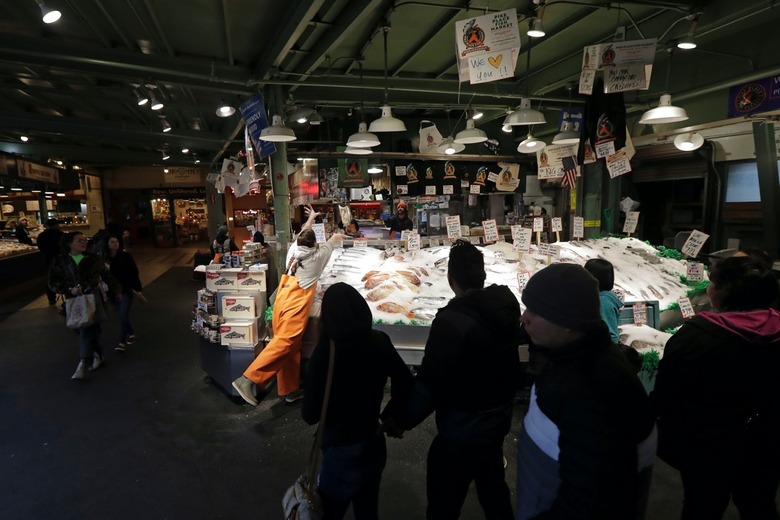Everyone Was Wrong About China's Latest Coronavirus Outbreak In Beijing
- The coronavirus outbreak in Beijing has nothing to do with salmon, Chinese officials confirmed after initially associating the new COVID-19 flare-up with the fish.
- Authorities in China removed the salmon stock from stores and stopped imports after finding traces of SARS-CoV-2 on chopping boards in a Beijing market.
- The panic was unfounded, experts explained. The novel virus can't infect fish, and samples from other imported salmon tested negative for COVID-19.
Last week, Chinese authorities announced the discovery of a new cluster of novel coronavirus community transmission. A man came to a clinic with a fever and his COVID-19 test came back positive. He had no idea where he got the illness from, as he had not traveled abroad and he was not in contact with anyone who returned to the country. Authorities took swift action and discovered more active cases. In a matter of days, Beijing officials closed down several districts of the capital, which has a population of over 21 million people, and set up hundreds of testing sites. Schools were closed again, as were sporting and entertainment events.
But one of the most puzzling moves China made was to stop all salmon imports after finding traces of the SARS-CoV-2 virus on a chopping board in one of the major markets in the city. That market was closed a few days ago as a result. The salmon hypothesis raised alarms in the country and abroad, and exporters from Norway found themselves unable to conduct business with Chinese importers as a result.
Salmon sparking a coronavirus outbreak in Beijing made no sense, as it goes against everything we know about the way the disease is transmitted. Beijing officials have now confirmed that the fish had nothing to do with the outbreak, but that might not be enough to put people's minds at ease.
The novel coronavirus spreads from human to human via aerosolized droplets that contain the virus. These saliva particles are ejected by sneezing, coughing, or even just speaking loudly. Indoor crowds and ventilation can help aerosolized particles spread even farther, and people who do not wear masks or who touch their face without washing their hands can get infected.
The virus can start replicating inside the nose, but its favorite area of the human body is the lungs. It can attach itself to other organs as well. It's in the lungs where it starts spreading fast, however. Even asymptomatic patients can suffer some lung damage after infection, while the people who develop symptoms can experience a mild or severe COVID-19 case.
Eating food that may contain tiny traces of the virus is believed to be completely safe, especially if it's cooked or reheated properly. The virus can't survive intense heat. Even on uncooked food, it will likely end up in your digestive system and have no way of getting into your lungs. The same goes for salmon.

Residents queue up to be tested at a fever clinic in Beijing. China's capital was bracing Monday for a resurgence of the coronavirus after more than 100 new cases were reported in recent days in a city that hadn't seen a case of local transmission in more than a month.
The salmon panic is very real. In a matter of days, Beijing authorities removed salmon supplies from supermarket shelves, dumped reserves, and canceled orders, The New York Times reports. It ended up being an overreaction that can harm businesses and consumer trust in salmon products. But China probably doesn't want to risk being accused of not taking immediate action and being transparent about another outbreak.
Chinese officials said the imported salmon was not responsible for spreading the virus, but the damage was already done. China's Center for Disease Control said at a news briefing this week that there was no evidence to suggest salmon can host the new coronavirus. Officials have not ruled out the possibility that seafood products were contaminated during packaging.
China believes the coronavirus strain in Beijing may have been imported from Europe, as it's similar to the version of the virus that is now present in European countries and the United States. However, it's unclear how the virus made its way to Beijing. The capital was COVID-19-free for 57 days before last week's outbreak.
"Viruses must rely on the viral receptor on the host cell surfaces to infect cells. Without the certain receptor, they cannot enter into cells successfully," Tsinghua University virologist Cheng Gong told CGTN. "All known evidence so far suggests this kind of receptors exist only in mammals, not fish."
In early April, the World Health Organization (WHO) said that "coronaviruses cannot multiply in food; they need an animal or human host to multiply." WHO also said it was highly unlikely the virus spread through packaging.
Hong Kong's Centre for Food Safety confirmed that none of the 16 samples of imported salmon from countries including Chile, Denmark, and Iceland had any traces of the virus. Norwegian officials said on Wednesday they concluded together with Chinese authorities that their fish was not the source of the coronavirus found in the Beijing market.
Since last Thursday, Beijing confirmed almost 150 new coronavirus cases in the city.
